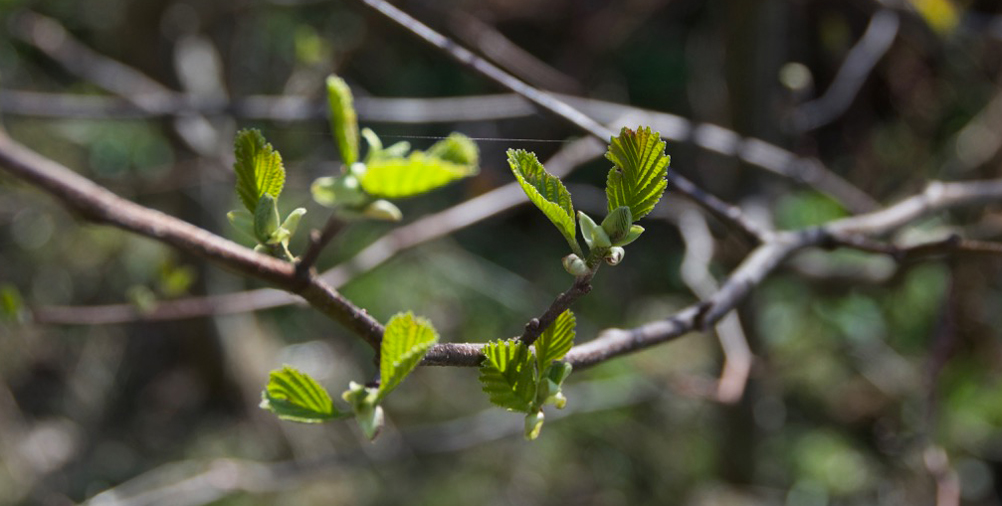
Leafburst
Spring has finally arrived with a splash of brilliant sunshine in this little corner of Argyll. The birds are in full song; in addition to the resident thrushes, blackbirds and robins we’ve heard chiffchaffs, willow warblers and a blackcap, and last Friday we saw the first swallow. Celandines and wood anemones are opening their lovely flowers, the former in full sunlight and the latter in dappled shade beneath the beech trees. The first violets are peeping through the litter of last year’s bracken, and the grassy banks and verges are speckled with primroses.
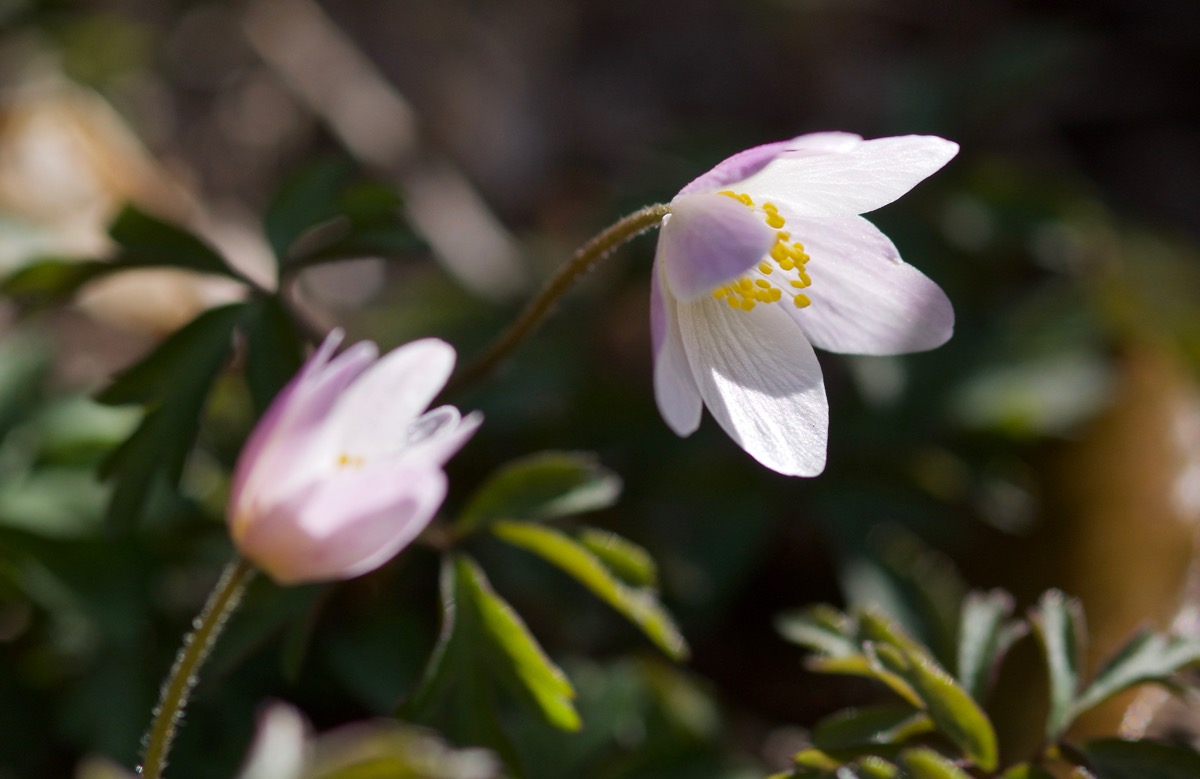
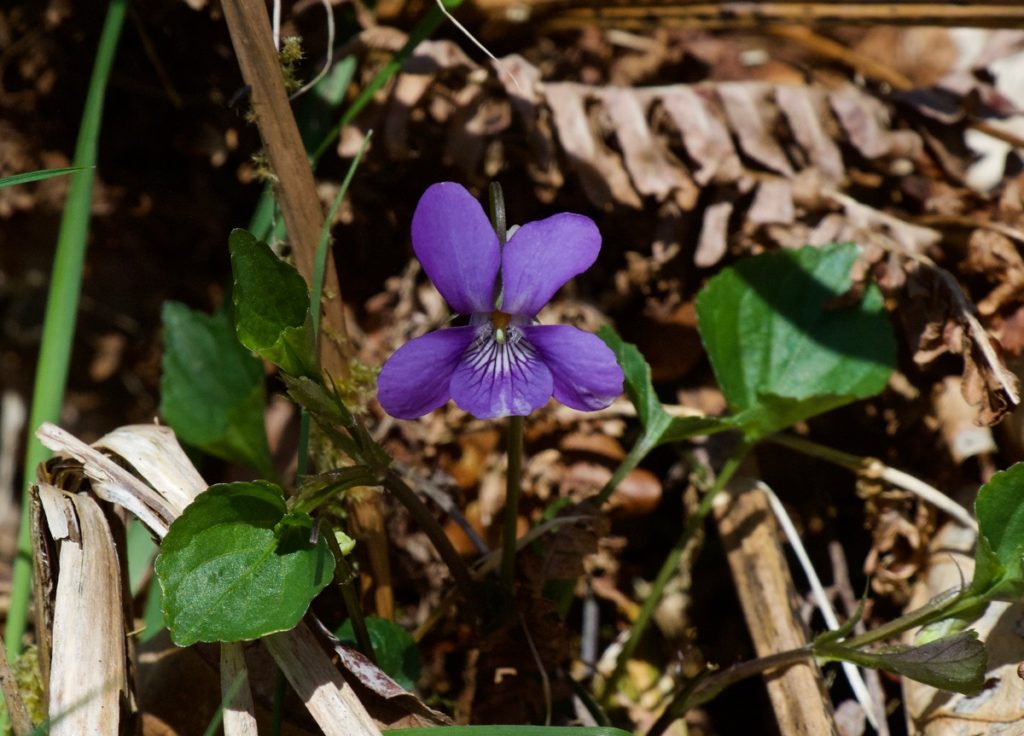 The trees seem to have made a fairly unanimous decision to burst into leaf. Some are further ahead than others: the horse chestnut, for example, is always among the first, and has already put up bold candle-like spikes of flower buds, surrounded by young leaves still limp and awaiting the rise of the sap. Others, like the oak and the ash, are holding their buds as tight as fists, but the first signs of flowers are there, and this week’s sunshine will surely draw them out.
The trees seem to have made a fairly unanimous decision to burst into leaf. Some are further ahead than others: the horse chestnut, for example, is always among the first, and has already put up bold candle-like spikes of flower buds, surrounded by young leaves still limp and awaiting the rise of the sap. Others, like the oak and the ash, are holding their buds as tight as fists, but the first signs of flowers are there, and this week’s sunshine will surely draw them out.
Yesterday morning we wandered down the road in an attempt to photograph as many species as possible, and found more than we expected. I thought you might enjoy a little paragraph about each one.
ALDER
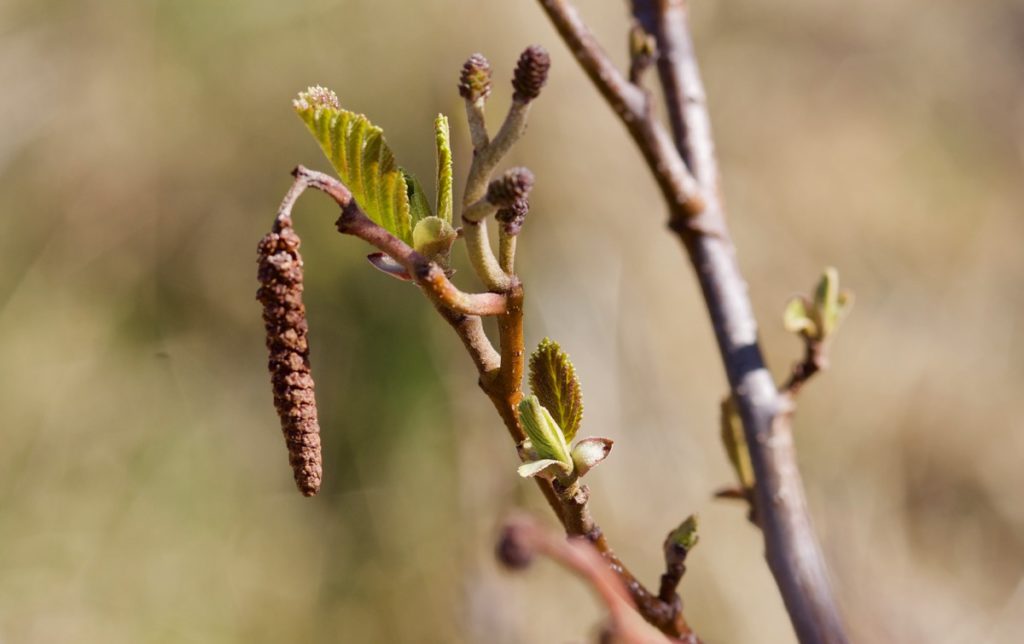 Alder leaves are easier to identify if you can also see last year’s cones and catkins. They open like tiny fans, fresh green infused with golden brown. I’d always overlooked alders until I started to take more notice of trees. Wherever there is a pool or a burn they are there, happily rooted in the boggy ground and bending their branches over the water’s surface.
Alder leaves are easier to identify if you can also see last year’s cones and catkins. They open like tiny fans, fresh green infused with golden brown. I’d always overlooked alders until I started to take more notice of trees. Wherever there is a pool or a burn they are there, happily rooted in the boggy ground and bending their branches over the water’s surface.
Alder wood is extremely water-resistant, a quality which was well known to our ancestors. In the Welsh Mabinogion, alder was the emblem of the Celtic giant-god, Bran, who laid down across the River Llinon in order to create a bridge for his soldiers to pass safely across. Alder wood was often chosen for building trackways across marshy ground, and it seems to have been a popular choice for warriors’ shields, possibly because of the wood’s fiery orange colour.
Sure-hoofed is my steed impelled by the spur;
The high springs of alder on thy shield;
Bran thou art called, of the glittering branches.
Sure-hoofed is my steed in the day of battle:
The high sprigs of alder are in thy hand:
Bran thou art, by the branch thou bearest
Has Amaethon the Good prevailed!
(Translation of Welsh englyn associated with the Cad Goddeu, ‘The Battle of the Trees’, in the 14th century Book of Taliesin)
WILLOW
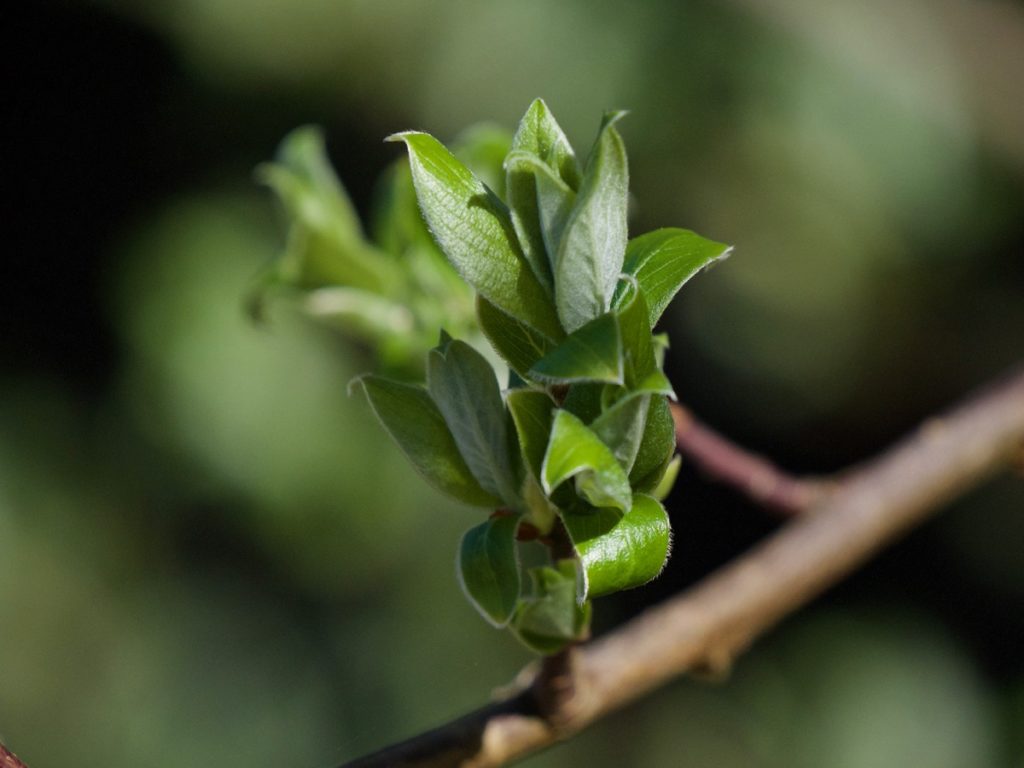 There are at least 18 species of willow in Britain and a further 27 hybrids, and correctly identifying them can be a challenge even for botanists. According to naturalist Edward Step (Wayside and Woodland Trees, 1905) the word ‘willow’ comes from the Anglo-Saxon welig, indicating pliancy or willingness, and since early times their flexible branches have been cut and used for making baskets, screens, hurdles and cradles.
There are at least 18 species of willow in Britain and a further 27 hybrids, and correctly identifying them can be a challenge even for botanists. According to naturalist Edward Step (Wayside and Woodland Trees, 1905) the word ‘willow’ comes from the Anglo-Saxon welig, indicating pliancy or willingness, and since early times their flexible branches have been cut and used for making baskets, screens, hurdles and cradles.
One morning last spring, I stood and watched as thousands of feathery seeds drifted silently away from the topmost catkins of willow trees down the road, each one lit momentarily by the sun and twirling gently as it caught the breeze. It looked as if a host of faeries was passing through the branches. I was spellbound.
ROWAN or MOUNTAIN ASH
In his Wayside and Woodland Trees (1905), naturalist Edward Step offers this delightful insight:
“The word Rowan is one of the most interesting of tree-names, and connects the still-existing superstitious practices of our northern counties, not only with the old Norsemen, but with the ancient Hindus who spoke the Sanskrit tongue. The word is spelled in many ways which connect it with the Old Norse runa, a charm, it being supposed to have power to ward off the effects of the evil eye. In earlier times runa was the Sanskrit appellation for a magician; run-stafas were staves cut from the Rowan-tree upon which runes were inscribed. Until quite recently the respect for its magical properties was shown in the north by fixing a branch of Rowan to the cattle-byre as a charm against the evil designs of witches, warlocks, and others of that kidney.”
In winter, rowan trees are sometimes difficult to distinguish from ash, but as the leaves start to emerge they reveal the tiny clusters of green buds that will soon develop into frothy white flowers.
HAWTHORN
The speedy hawthorn, first of all
To show the spring its tender green…
(John Clare)
In a mild spring the hawthorn can be among the first to put out its leaves, especially if it is growing in a sheltered hedge. Its abundant flowers – the traditional May blossom – will open later, to the delight of thousands of insects. In former centuries, May blossom was thought to indicate the arrival of summer, but folklorist T F Thiselton-Dyer offered a word of caution:
When the hawthorn bloom too early shows,
We shall still have many snows.
(The Folk-lore of Plants, 1889)
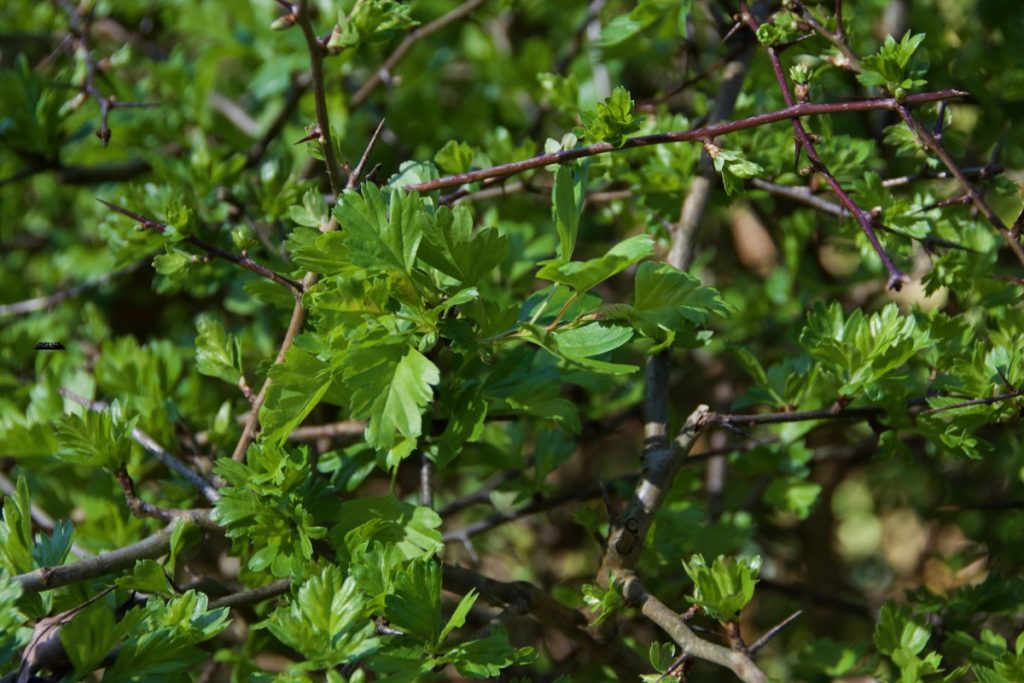 We won’t see the flowers for a while yet, but the fresh growth of leaves is a cheering sight – and they will be welcomed also by the small birds that are already thinking of nesting in their dense, thorny cover.
We won’t see the flowers for a while yet, but the fresh growth of leaves is a cheering sight – and they will be welcomed also by the small birds that are already thinking of nesting in their dense, thorny cover.
ELDER
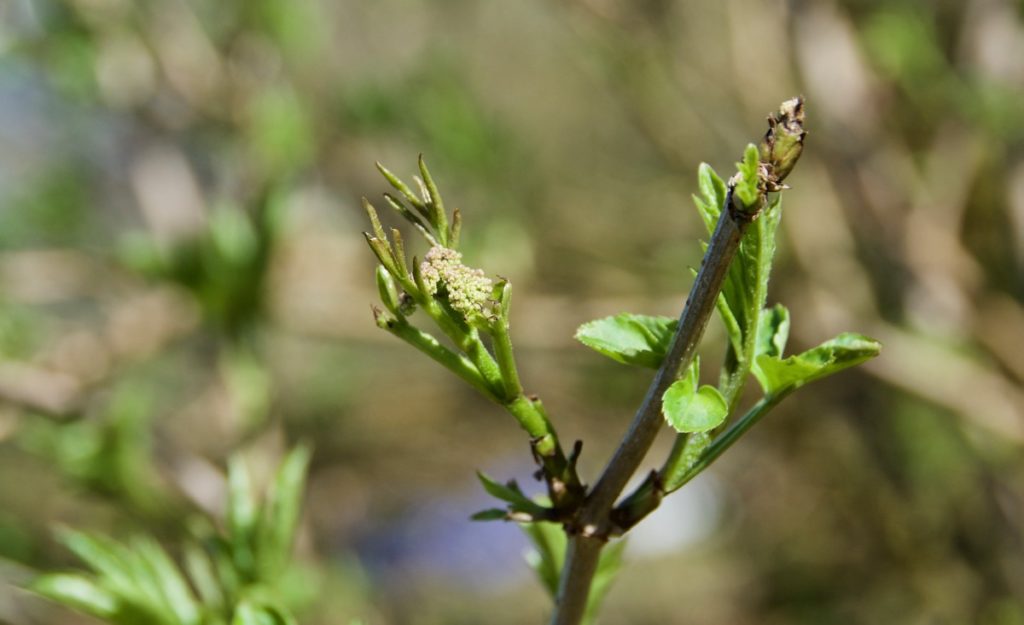 As elder leaves unfold they bring with them tiny bead-like clusters of buds; in time, these will blossom into the exuberant, creamy-white flowerheads that smell so distinctively of summer. Elder is another tree that’s easily missed, but once you spot the characteristic gnarled trunk, often quite slim in comparison to other trees, you can be pretty sure it’s an elder. I’ve found elders in some interesting sites, close to ancient stones and cairns, but this one is just across the road from our house.
As elder leaves unfold they bring with them tiny bead-like clusters of buds; in time, these will blossom into the exuberant, creamy-white flowerheads that smell so distinctively of summer. Elder is another tree that’s easily missed, but once you spot the characteristic gnarled trunk, often quite slim in comparison to other trees, you can be pretty sure it’s an elder. I’ve found elders in some interesting sites, close to ancient stones and cairns, but this one is just across the road from our house.
The word ‘elder’ is believed to derive from the Scandinavian tree-spirit Hylde-Moer and the Anglo-Saxon eldrun. According to folklore, the tree is jealously protected by a guardian known as the elder-mother, and nothing must be cut from her branches without her permission. Elder wood was rarely burnt, partly out of superstition and partly because it makes a poor firewood; but its hollowed-out twigs made good bellows to fan the flames.
BIRCH
The lonely shepherd loves to mark
The daisy springing fair,
Where weeps the birch of silver bark
With long dishevell’d hair.
(Sir Walter Scott, from Minstrelsy of the Scottish Border)
Graceful and pliant, birch is the tree of love and fertility, of maypoles and birch brooms, perhaps symbolising more than any other tree the sweeping away of old energy and the arrival of fresh new life. Birch twigs were used to kindle the fires of Beltane on 1st May, and were hung over doorways on Midsummer’s Eve. This week’s sunshine has encouraged the first show of small, teardrop-shaped leaves which make a bold splash against the dark twigs.
SYCAMORE
I think sycamore leaves are at their best in early spring, bright green and full of vibrant life, before their colour deepens and darkens in summer. Traditionally, sycamore sap has been used to make ale, and in Montgomeryshire a sprig of sycamore was said to prevent mischievous fairies from spoiling the milk. In parts of the West Country, sycamore leaves were gathered and used as the base on which to bake small cakes at Easter or harvest time; when they came out of the oven, the cakes had a distinctive leaf pattern on the underside.
ELM
The elms that we have in Argyll (and much of Scotland) are native wych elms, Ulmus glabra, which is abundant in upland areas. The two trees across the road from us are an impressive height, and look spectacular when they’re swaying around in westerly gales. At present, their lower branches are just coming out into leaf.
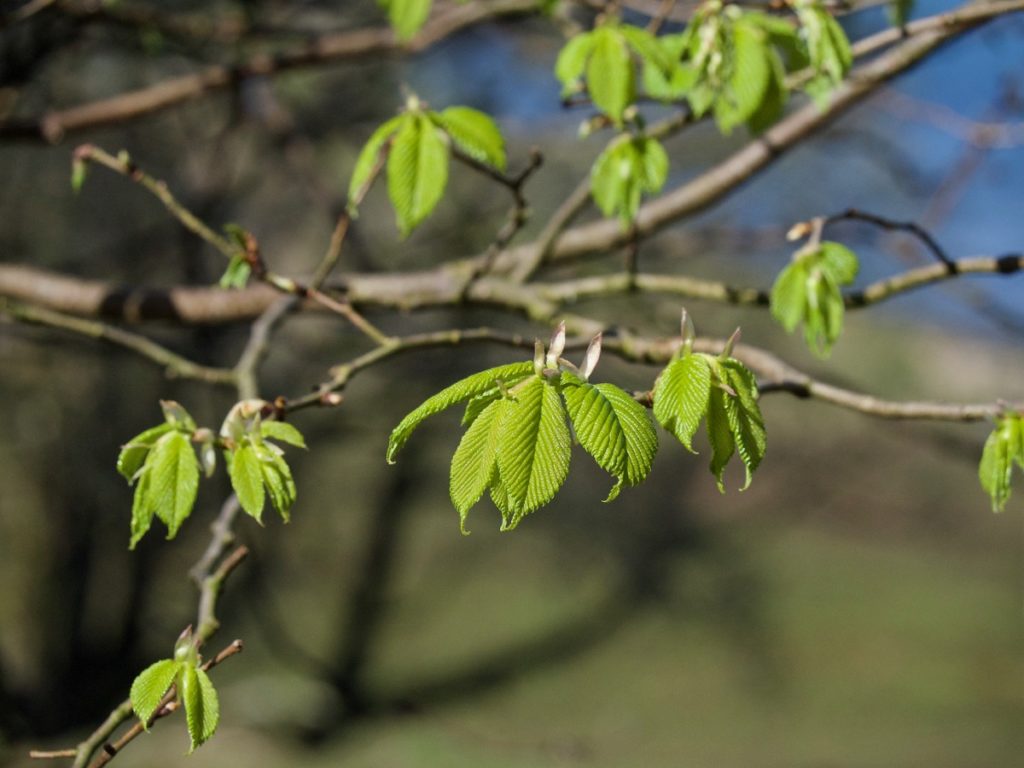 In times past, the emergence of elm leaves provided guidance for sowing crops:
In times past, the emergence of elm leaves provided guidance for sowing crops:
When the elmen leaf is as big as a mouse’s ear,
Then to sow barley never fear;
When the elmen leaf is as big as an ox’s eye,
Then says I, Hie, boys, Hie!’
When elm leaves are as big as a shilling,
Plant kidney beans, if to plant ‘em you’re willing;
When elm leaves are as big as a penny,
You must plant kidney beans if you want to have any.
(Traditional rhyme, quoted in A Dictionary of Plant Lore by Roy Vickery)
HAZEL
The yellow male catkins which appeared in January and February are now fading to brown, but a few of the small, bright pink female flowers are still visible. These little strands actually represent the stigma and styles of a small group of flowers. Leaf bracts are opening around them, and if they have been fertilised they will eventually turn into the familiar hazelnuts of autumn.
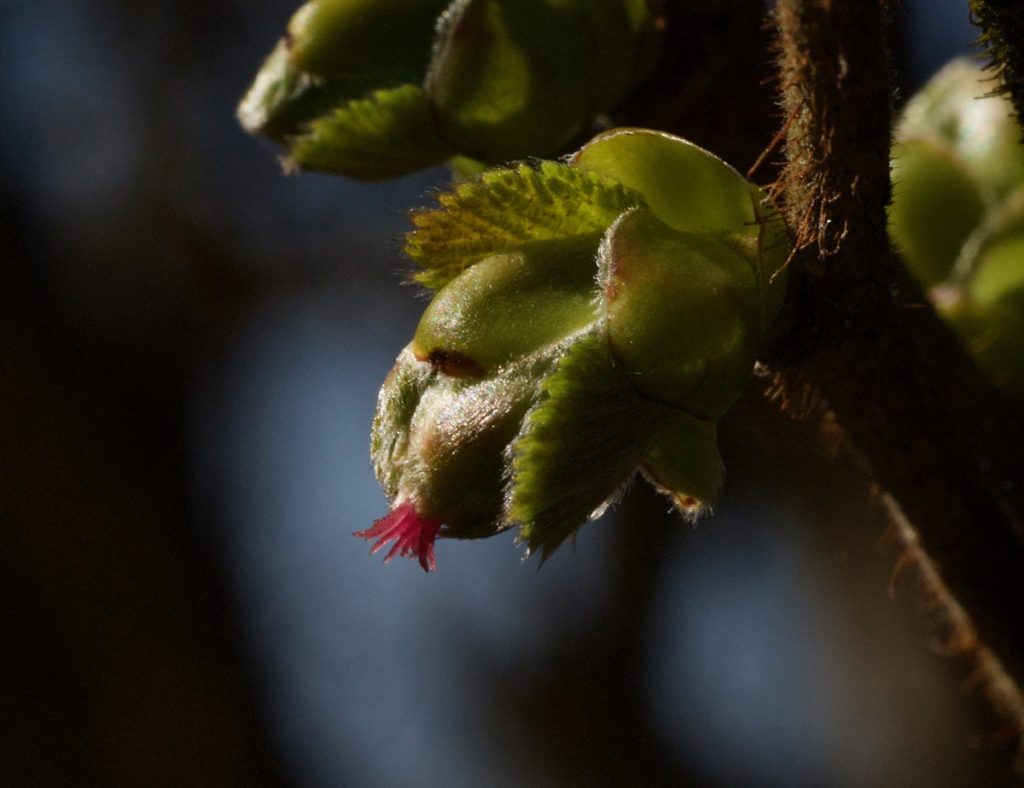 Throwing up a multitude of slim, straight stems, hazel is naturally self-coppicing and for untold centuries it has been cut for making rods, hurdles and poles. One of Ireland’s seven noble trees, hazel was believed to offer protection from fairies, and was often claimed to be the best material for creating wands. Edward Step writes: “Its tough and pliant rods and staves are valuable for many small uses, such as the making of hoops for casks, walking-sticks and divining rods.”
Throwing up a multitude of slim, straight stems, hazel is naturally self-coppicing and for untold centuries it has been cut for making rods, hurdles and poles. One of Ireland’s seven noble trees, hazel was believed to offer protection from fairies, and was often claimed to be the best material for creating wands. Edward Step writes: “Its tough and pliant rods and staves are valuable for many small uses, such as the making of hoops for casks, walking-sticks and divining rods.”
The leaves of hazel are similar in shape to wych elm, with a pronounced drip tip, but are soft and slightly furry to touch.
HORSE CHESTNUT
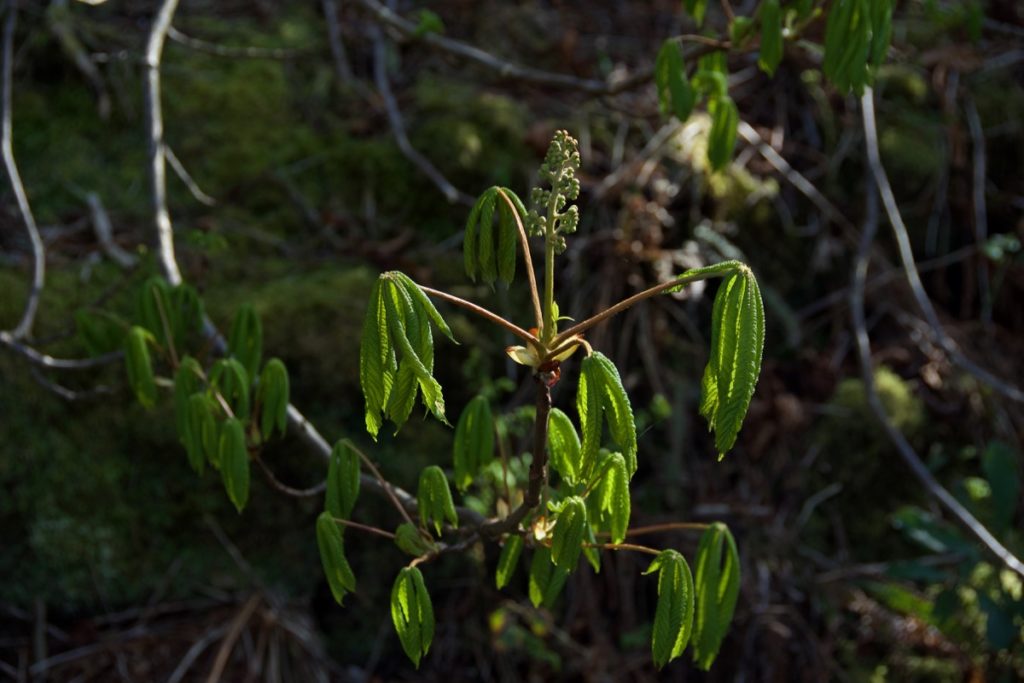 Arguably our showiest tree, horse chestnut is magnificent in the size of its leaves and of the tree itself. It grows wild in Northern Greece and Albania, and is thought to have been introduced to Britain in the early 1600s. As a landscaping tree for avenues and ornamental planting it was much favoured by the great garden designers, including Capability Brown.
Arguably our showiest tree, horse chestnut is magnificent in the size of its leaves and of the tree itself. It grows wild in Northern Greece and Albania, and is thought to have been introduced to Britain in the early 1600s. As a landscaping tree for avenues and ornamental planting it was much favoured by the great garden designers, including Capability Brown.
This horse chestnut, which grows a short way up the road from our house, is always one of the first to burst into leaf and is now eagerly hoisting its flower spikes. Likewise, by late summer it usually turns colour and sheds its leaves quickly, as if keen to be ahead of the changing seasons.
OAK
In contrast to the flamboyant horse chestnut, the flowers of an oak tree are tiny and understated. They emerge from brownish buds, so that from a distance, the tree looks to be flushed with a warm golden hue.
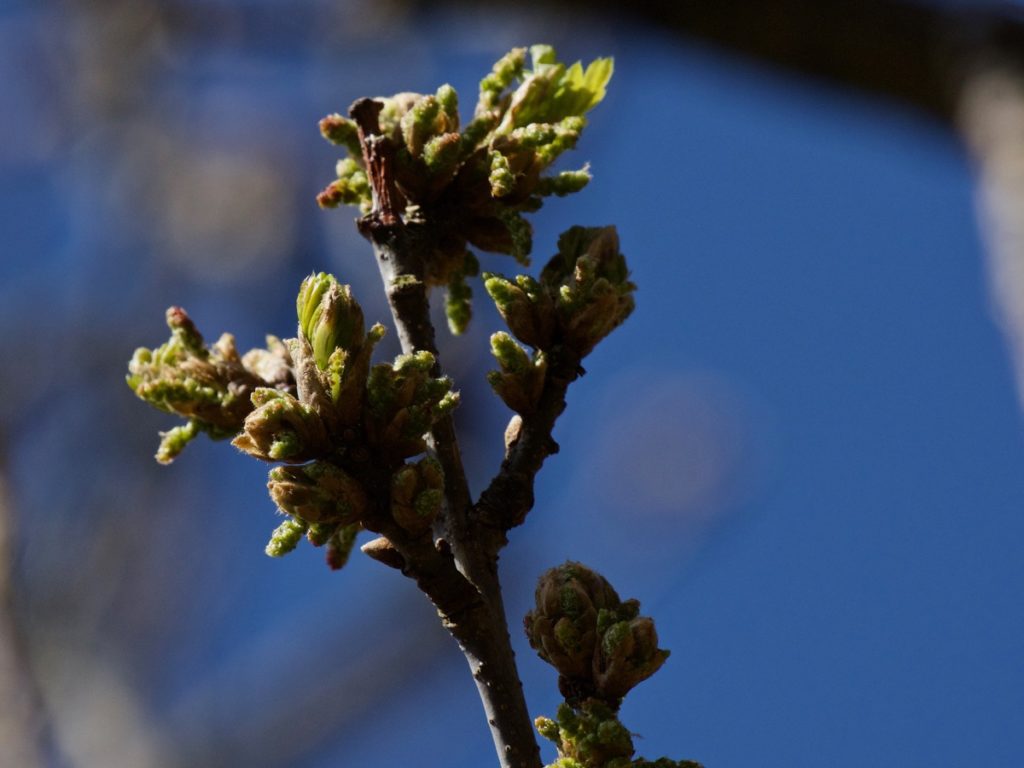 “The Druids,” wrote Pliny in the first century AD, “…hold nothing more sacred than mistletoe and a tree on which it is growing, provided it is an oak. Groves of oaks are chosen even for their own sake, and the magicians perform no rites without using the foliage of those trees…” (Natural History XVI, 249)
“The Druids,” wrote Pliny in the first century AD, “…hold nothing more sacred than mistletoe and a tree on which it is growing, provided it is an oak. Groves of oaks are chosen even for their own sake, and the magicians perform no rites without using the foliage of those trees…” (Natural History XVI, 249)
Oak is symbolic of monarchs, of power and steadfastness, and its lore has been woven into our culture over countless centuries. The Major Oak, the Birnam Oak, the Boscobel Oak… amazingly, some 700 individually-named oak trees are scattered about the country, each one a noble veteran with a unique and fascinating story to tell.
ASH
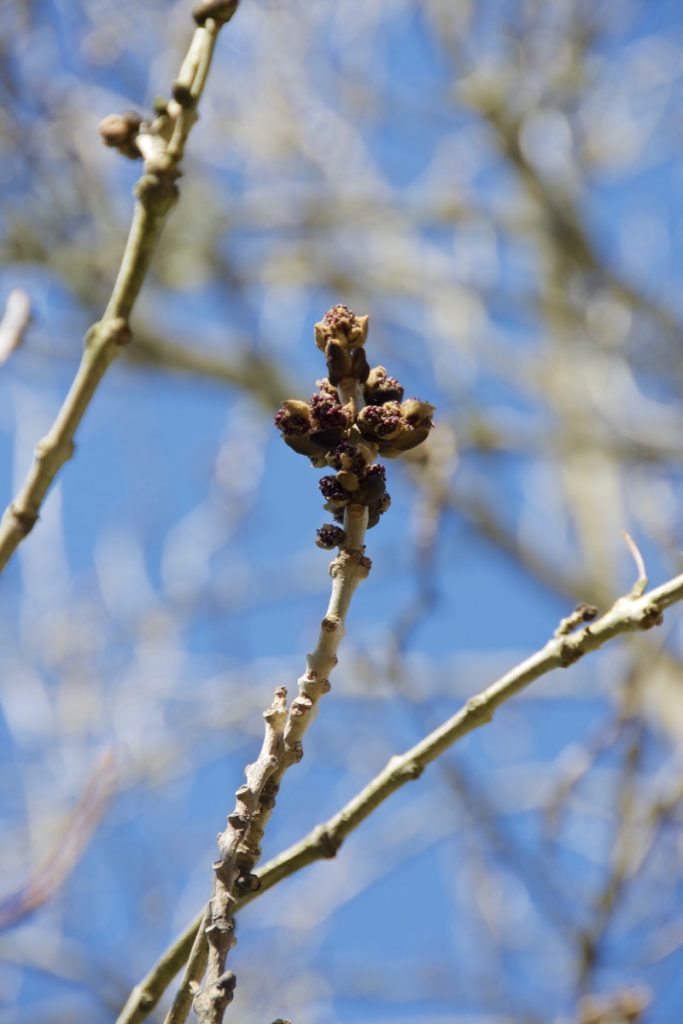 With its pale, smooth stems, ash always draws the eye in winter, and it’s often one of the last trees to come into leaf. Invariably, it has a contest – at least in our imagination! – with the oak, as we remember the old prophecy about the forthcoming summer:
With its pale, smooth stems, ash always draws the eye in winter, and it’s often one of the last trees to come into leaf. Invariably, it has a contest – at least in our imagination! – with the oak, as we remember the old prophecy about the forthcoming summer:
If the oak is out before the ash
Then the world will have a splash;
If the ash is out before the oak,
Then the world will have a soak.
Ash is significant in its own right, however. In some rural communities it was seen as a tree of mystery and magic, and people would wish it ‘good day’ when passing. No tree offered better protection against snakes, which were believed to be repelled by a rod of ash and would even avoid the shadow of the tree. And when it came to firewood, ash had no equal.
Beech wood fires burn bright and clear,
If the logs are kept a year.
Oaken logs burn steadily,
If the wood is old and dry.
But ash dry or ash green,
Makes a fire fit for a queen.
(Traditional poem)
Willows overlooking the sea towards Scarba and Jura. Sending you love, sunshine and blessings!
Photos copyright © Colin & Jo Woolf

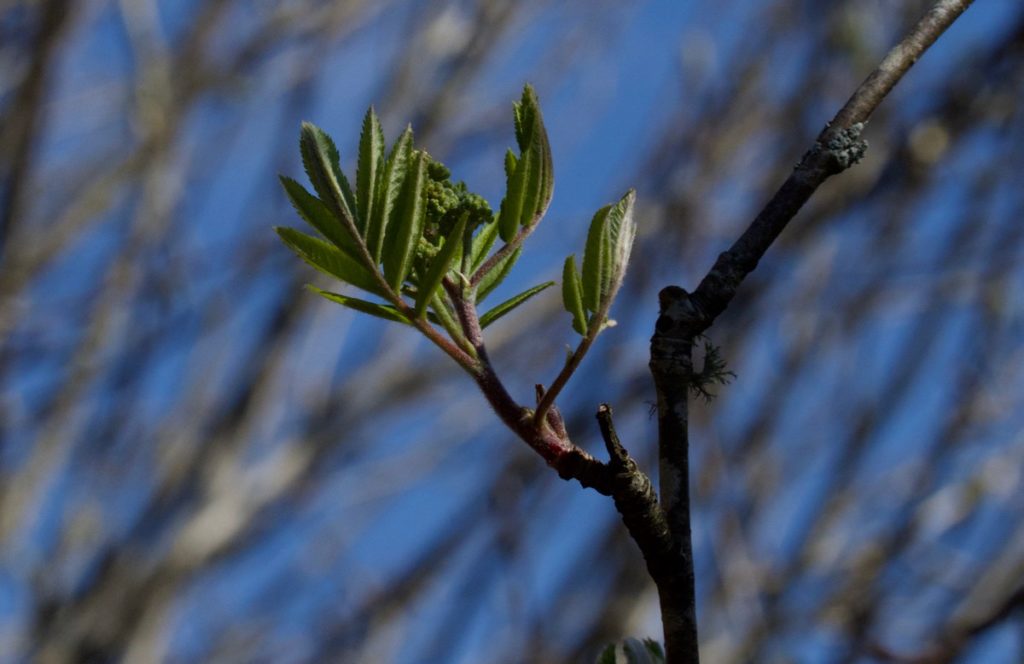
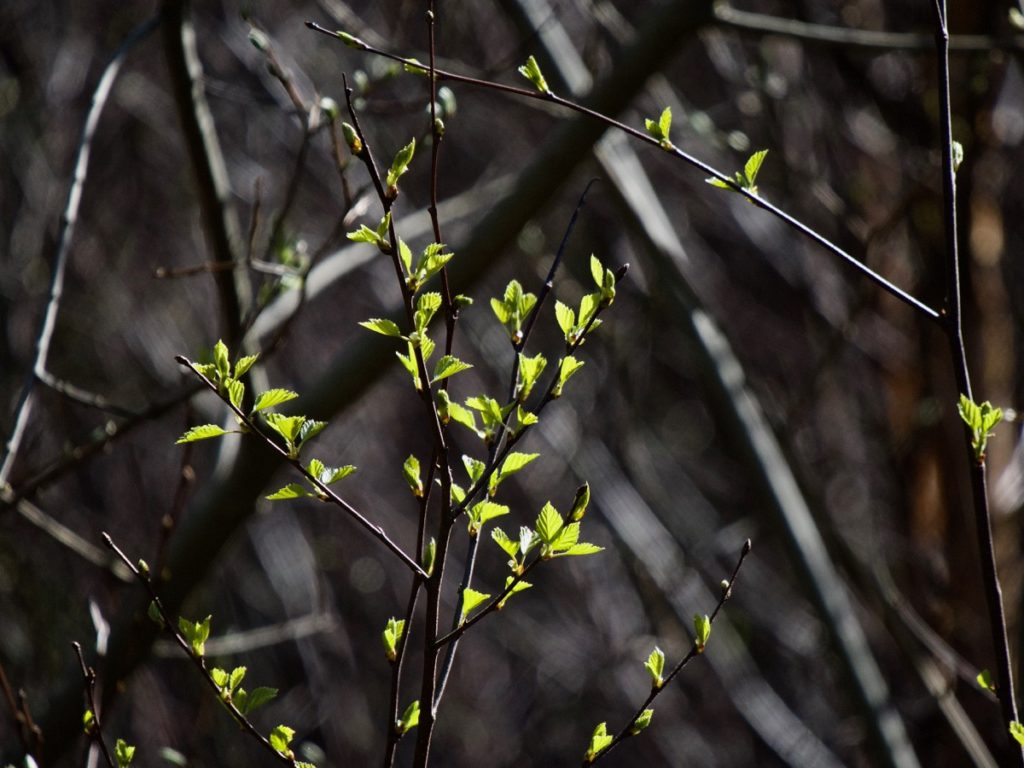
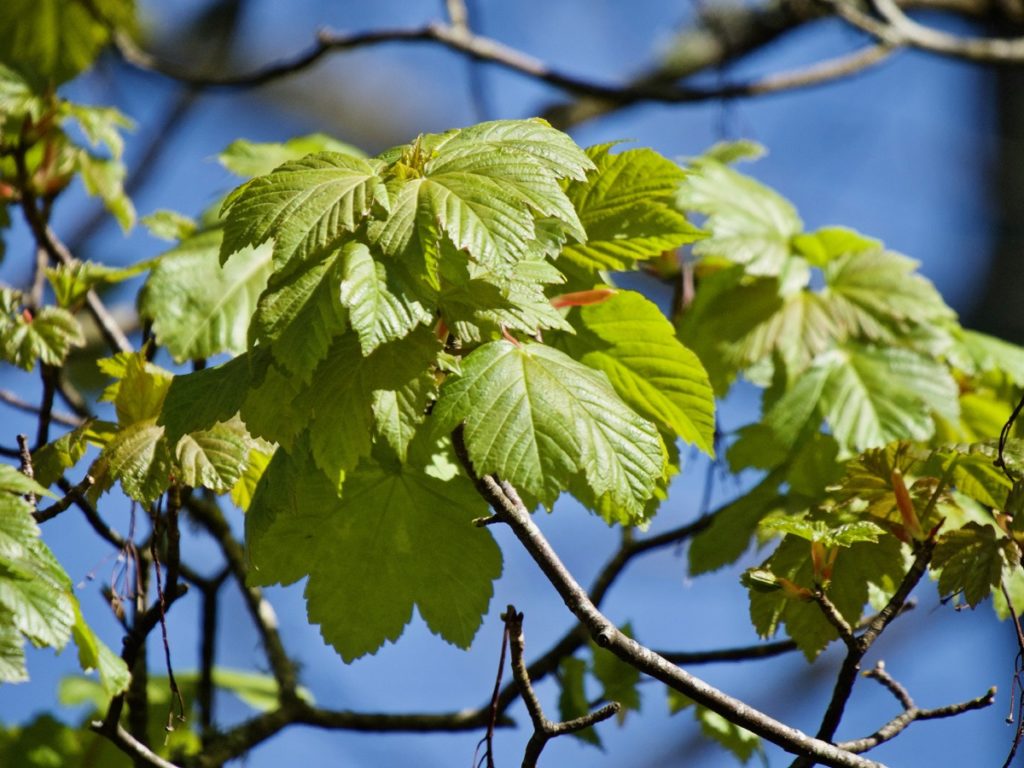
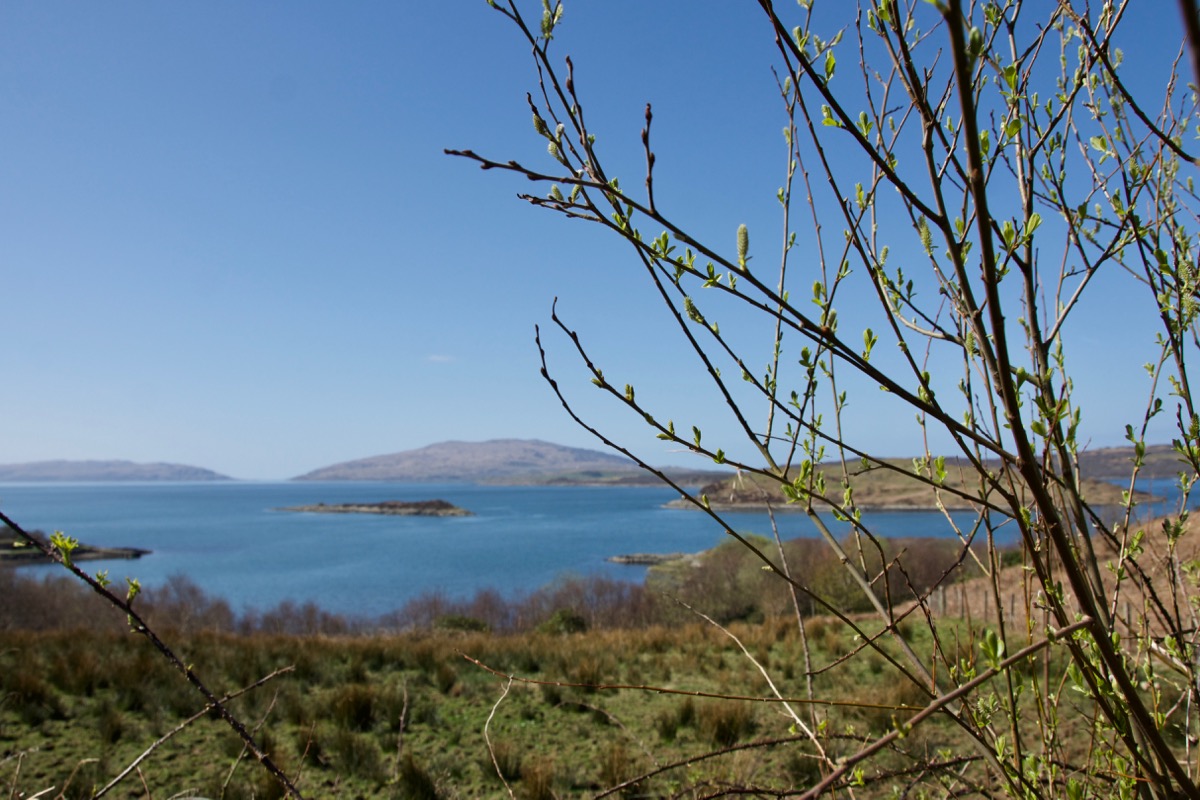
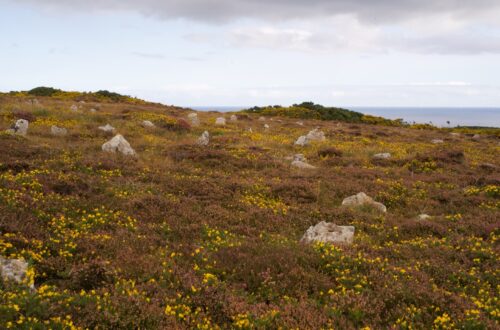
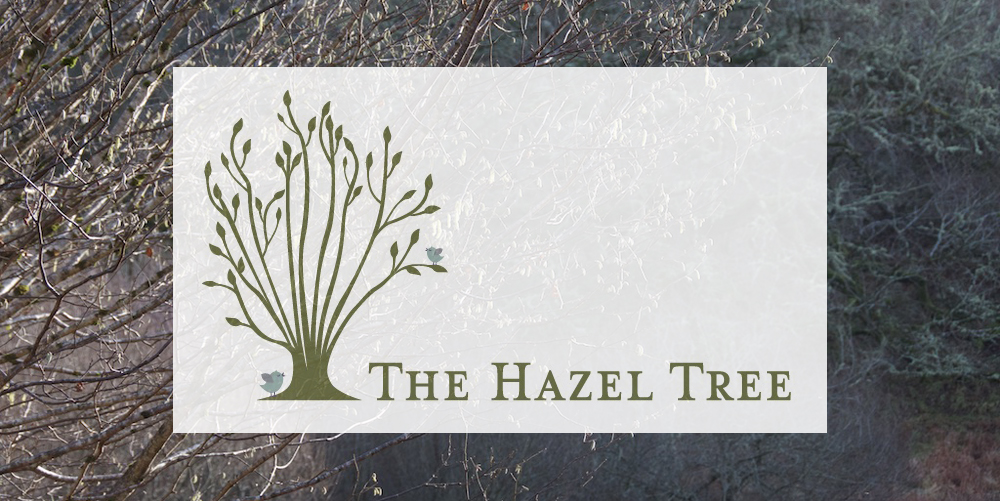
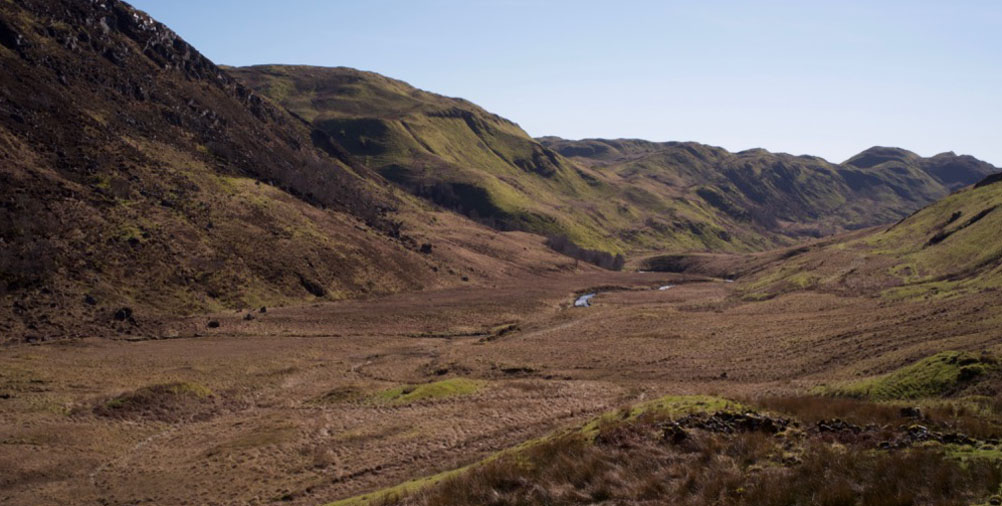
14 Comments
Norma Dowling
Thank you, Jo. A lovely Springtime post! Fortunately we have many trees in and round the boundaries of our Garden. and lots of birdsong. I’ve found Dandelions, Lesser Celandine, Violets and Lady’s Smock flowering. How lucky we are to have all this on the doorstop at this difficult time! Best wishes to all and Keep Safe! Norma, I of Mull
Jo Woolf
Thank you, Norma! Glad to hear you’re finding some spring flowers. We are indeed lucky to have all this natural beauty around us. Stay well and safe yourself, and warmest wishes, Jo
Darlene
This is a lovely post. Thank you.
I especially enjoyed the legends and poems that you included about each tree.
Jo Woolf
You’re most welcome, Darlene – really glad you enjoyed it. Sending you love and warmest wishes. x
theresa
What an inspiring post! Thank you so much.
Jo Woolf
Aw, thank you Theresa! You’re most welcome. Love and very best wishes x
Sigrid Baumann
Wonderful pictures and enchanting stories, witty rhymes and wisdoms that go with it – as always a HUGE pleasure to read your posts. Highly appreciated – thank you very much!
Jo Woolf
That’s so lovely, thank you Sigrid! Love and best wishes to you x
Finola
Great post, Jo. I am taking this with me on my walks to see what I can identify. Most striking tree with us at the moment is the Blackthorn. Do you have Guelder Rose where you are? I’m trying to see if the one near me has survived the winter.
Jo Woolf
Thank you, Finola! I hope you find lots of them. Yes, we’ve seen some blackthorn blossom and the wild cherry is just coming out. I’ve seen guelder rose somewhere but can’t remember where (!) – not sure if it’s local! Loving your posts on your own blog.
Ashley
Lovely post. In a couple of places you refer to Edward Step’s book, a copy of which I have, a 1940’s copy. I think it’s a real gem and it was given to me by an aunt when I was much (much) younger. Between many of the pages are dried leaves collected by her when she was a young girl. I treasure it. A joy to read your words here. Thanks.
Jo Woolf
How lovely! Edward Step’s book is one of my favourites too. My copy of Gertrude Nuttall’s ‘Trees and How They Grow’ has leaves pressed between the pages – I often wonder who collected them, and where! Thanks so much, Ashley – stay safe and all good wishes to you. – Jo
Tim Porteus
fantastic thank you
Jo Woolf
You’re most welcome, Tim! Warmest wishes to you.